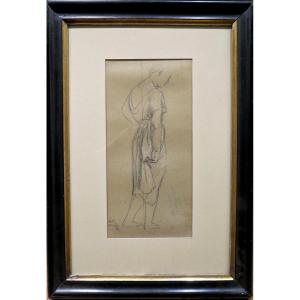(Paris, 1803 – Paris, 1866)
The Bravo
Oil on canvas
Signed lower left
54 x 46 cm
1832
Exhibitions: Paris Salon of 1833 under number 1829
Madame Brune, born Aimée Marie Alexandrine Pagès, pupil of Meynier, is one of the French women who distinguished themselves most in the arts, whether under the Restoration, the July Monarchy or the Second Empire. Still young, she obtained several orders from the government, and since then she has rarely let an exhibition pass without reaping new successes. She exhibited at the Paris Salon from 1822 to 1833 under her maiden name and then from 1834 until her last participation in 1853 under her married name. She obtained various medals at the Paris and provincial Salons, including in particular a first-class gold medal at the Salon of 1841.
We see by Madame Brune, in the galleries of Versailles, the Portrait of the Lord of Pontchartrain, executed after a painting kept at the Château de Beauregard; the Portrait of Mademoiselle Leclermont after Nattier – and that of Lieutenant General Count Morand – at the Troyes Museum, the Vœu, donated by the government after the Salon of 1837; at the Musée d'Orléans, a study of Young Girl Kneeling. Ten years her senior, Aimée Pagès married on July 24, 1833 Christian Brune (1793 – 1849) who was also a painter by trade and professor of drawing at the École polytechnique. It is very likely that they had the opportunity to collaborate on some of their paintings, she being gifted for characters, he more for landscapes.
The artist died in Paris on August 11, 1866 in his sixty-third year.
Museums: Amiens, Bordeaux, Dijon, Eu, Laval, Nîmes, Orléans, Paris (Mus. Carnavalet, Mus. de l’Armée, Mus. du Louvre), Troyes, Versailles…
Our painting takes as its theme The Bravo, a novel written by the American author James Fenimore Cooper (1789-1851). The Bravo, whose plot takes place in Venice, names nothing more or less than a contract killer in Italian slang. This Venetian story, first published in English in 1831, was immediately translated into French. The scene romantically illustrates the moment when Gelsomina goes to the doge to beg him to pardon her lover Jacopo Frontoni.
This novel had a rapid and frank success as demonstrated by the many representations that were made of it in painting during the decade 1835-1845. The work of Aimée Brune-Pagès was therefore the first of a long series in which painters such as Pierre Perlet, Félix Cottrau, Madame Clément, Mademoiselle Irma Martin, Charlemagne-Oscar Guet were also able to shine.
































 Le Magazine de PROANTIC
Le Magazine de PROANTIC TRÉSORS Magazine
TRÉSORS Magazine Rivista Artiquariato
Rivista Artiquariato